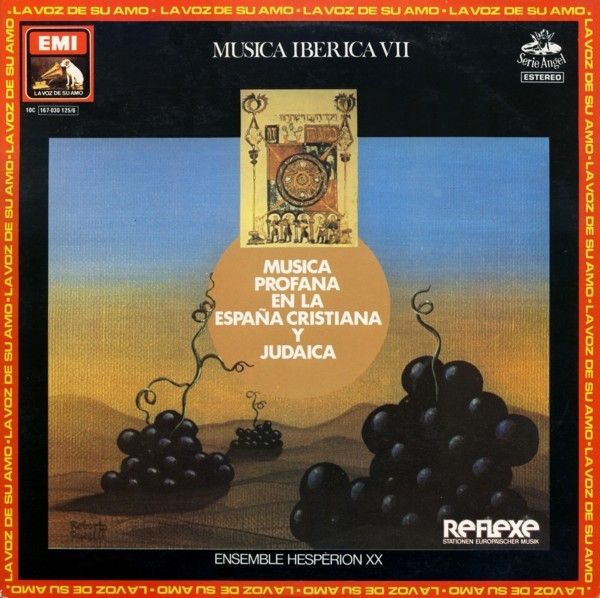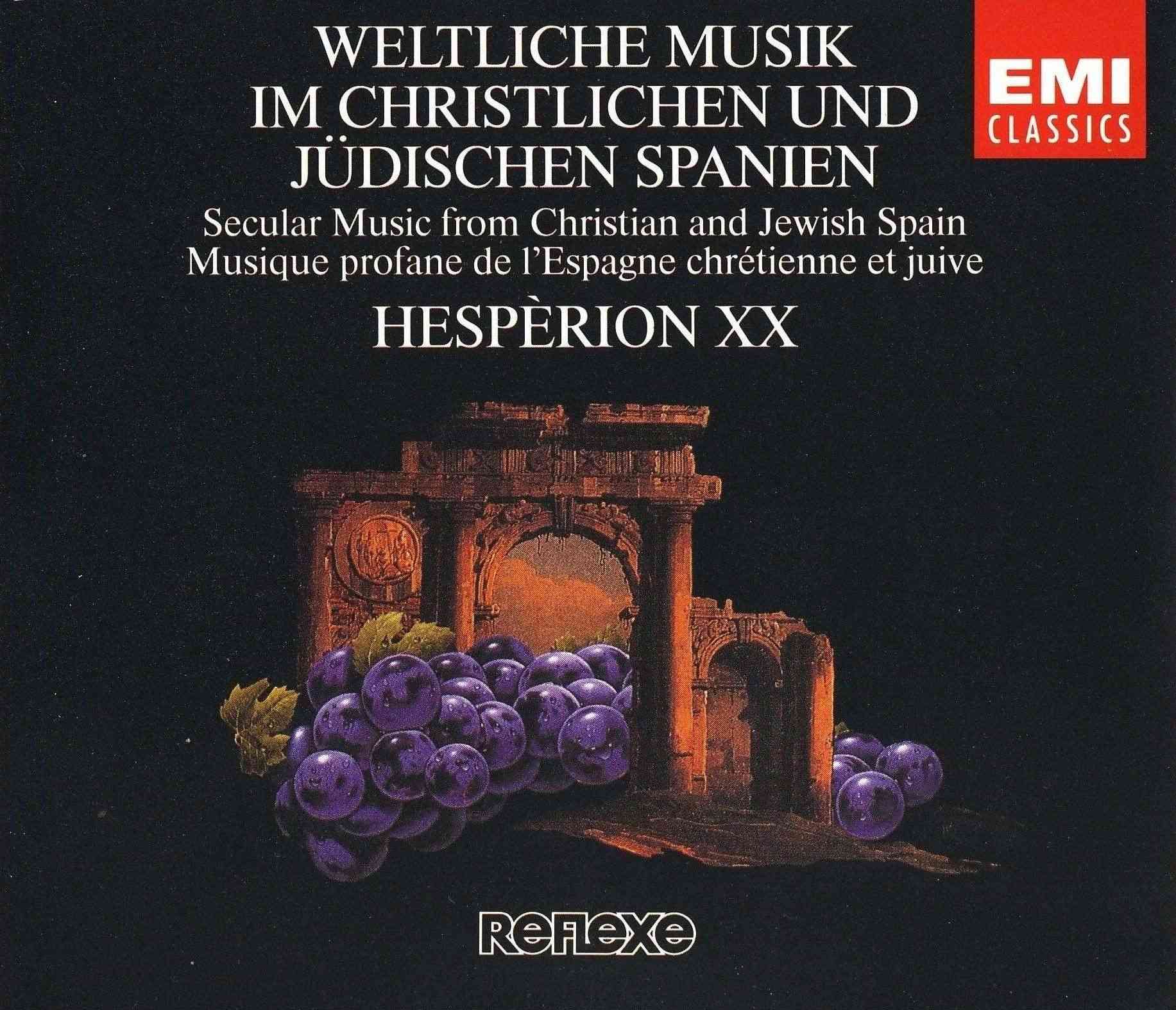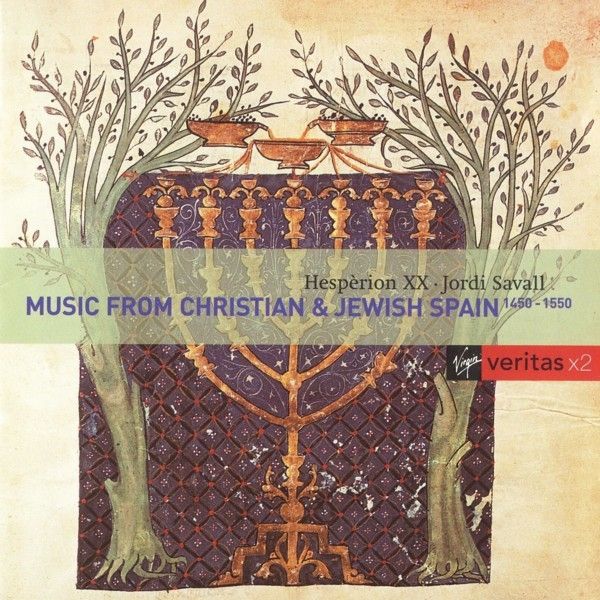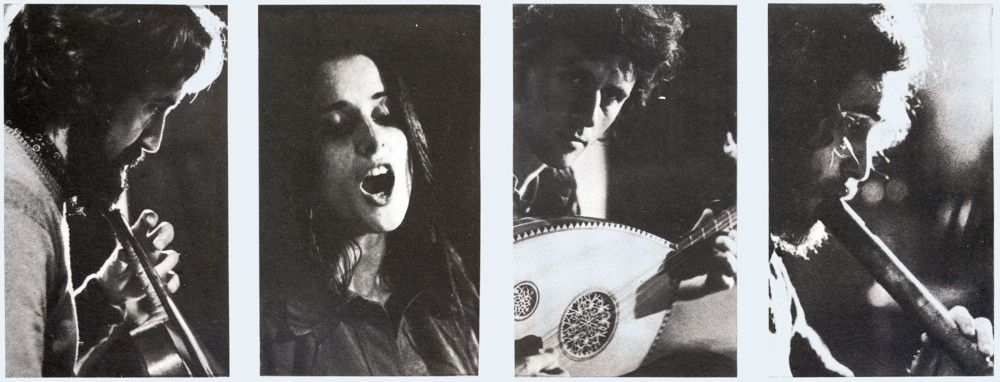Música profana en la España cristiana y judía / Hespèrion XX
Weltliche Musik im christilichen und jüdischen Spanien

medieval.org
LPs:
EMI-Odeón 10C1167-030 125/6 (1980)
edición original: EMI "Reflexe" 1C 163 30 125/26 (1976)
CDs:
EMI "Reflexe" CDM or 555 7 63 431 2 (1991)
Virgin Veritas "x2" 7243 5 61591 2 9 (1999)
CD1 | LP I
MÚSICA
CORTESANA Y CANCIONES FEMENINAS
en la época del Descubrimiento (1492-1543)
LP I A
Villancicos del Cancionero de la Colombina
(fines del siglo XV)
1. Niña y viña [1:36]
2. Propiñán de melyor (instr.)
[1:43]
3. ¿Cómo no le andaré yo? [2:22]
4. Recercada (instr.) [1:38]
Luys de MILÁN (c.1500-c.1561)
5. Fantasia (instr.) [2:16]
6. Pavana (instr.) [1:54]
Villancicos del Cancionero de Palacio
(1490-1535)
7. Al alva venid [3:49]
8. Perdí la mi rrueca [2:22]
9. A los baños del amor [1:36]
10. Fantasía (instr.) [1:40]
11. Romanesca (instr.) [1:15]
12. GARCIMUÑÓS. Pues bien para esta [3:20]
13. Si avéis dicho, marido [1:59]
LP I B
Romances del Cancionero de Palacio
14. Si d'amor pena sentís [5:13]
15. ROMÁN. O Voy (instr.) [1:59]
16. Juan del ENCINA (1468-1529). ¿Qu'es de ti, desconsolado?
[5:33]
Diego ORTIZ (1525-?).
Recercadas sobre tenores
17. Recercada 4 [1:42]
18. Recercada 5 [2:20]
19. Recercada 6 [1:19]
Villancicos del Cancionero de Uppsala
(1500-1550)
20. Yo me soy la morenica [1:11]
21. Si la noche haze escura [3:48]
22. Soleta só jo ací [1:33]
23. ¿Con qué la lavaré? [3:53]
24. Soy serranica [1:17]
CD 2 | LP II
ROMANZAS SEFARDÍES
de la época de la expulsión de judíos de
España (1492)
LP II A
01. Pregoneros vay y vienen [5:10]
02. El rey de Fancia tres hijas tenía [5:13]
03. Una matica de ruda [2:52]
04. Palestina hermoza (instr.) [1:32]
05. Nani, nani [6:07]
06. El rey que tanto madruga [3:08]
LP II B
07. Por qué llorax blanca niña [7:33]
08. Moricos los mis moricos [2:59]
09. Lavava y suspirava [5:38]
10. Paxarico tú te llamas (instr.) [1:52]
11. La reina xerifa mora [5:56]
12. Por allí pasó un cavallero [3:02]
Hespèrion XX
Jordi Savall
Montserrat Figueras, soprano
Jordi Savall, tenor y bajo de gamba, fidel y guitarra sarracena
Hopkinson Smith, laúd renacentista, laúd y
guitarra sarracena
Lorenzo Alpert, flauta e instrumentos de percusión
con
Arianne Maurette, gamba
Pere Ros, gamba
Pilar Figueras, cornamusa
Gabriel Garrido, percusión
LPs:
Grabación efectuada en el Münstermuseum de Basilea
Portada: diseño de Roberto Patelli
Ilustraciones: Giraudon, París
Fotos: Josef Beck, Zurich
Producción: GERD BERG
Sonido: JOHANN-NIKOLAUS MATTES
Editado e impreso por EMI-Odeon, S.A. - Barcelona
Depósito Legal: B.1796 - 1980 Ⓟ
CD EMI:
Produzent: Gerd Berg
Tonmeister: Johann-Nikolaus Matthes
Aufgenommen: XI.1975, Münstermuseum, Basel
Titelseite: Roberto Patelli
Ⓟ 1976 & Digital remastering © 1991 by EMI Electrola GmbH
© 1991 EMI Electrola GmbH
Comentarios en español de los LPs:
Música de corte y Villancicos (David Fallows)
La interpretación (David Fallows)
El villancico (Antonio Sánchez Romeralo)
Romanzas sefardíes
La música
Comentario de las canciones

Court Music and Villancicos
The song-book called the Cancionero de Palacio may have been prepared
at the royal court of Ferdinand or at that of the Duke of Alba. It
belongs to an important medieval tradition: the attempt to collect an
entire repertory either as a monument for posterity or as an expression
of pride in the repertory for its own sake. Several hundred pieces are
unique to this source; many composers are named only here; and
otherwise unknown formal details give important and interesting
information about the early history of the tradition. Not that it is
the only source for Spanish music at the time; the earlier manuscript
at Seville and the later ones at Segovia, Elvas and Barcelona also
contain small selections of the repertory. But from those traces nobody
could have guessed the enormous range and vitality of the Spanish song
tradition as represented in the Cancionero de Palacio.
Of the 450-odd surviving pieces in the Cancionero de Palacio,
the great majority are in villancico form, a musico-poetic
scheme which is more condensed and economic than any of the other forms
employed in European art-song at the time. Its main virtue is its
clarity, for the simple contrast of refrain (estribillo) and
verse (mudanza) allows of enormous flexibility in the details.
Two other cancioneros included here give even broader scope to
the variety of the villancico. The Cancionero de la
Colombina at Seville belonged to Ferdinand Colombus, the son of the
explorer, and is the earliest source for the repertory; indeed, it is
the first known surviving manuscript of Spanish polyphony since the
small Llibre Vermell of around 1400. The Colombina manuscript
shows that French and Italien polyphony were also known there, but
through all the years the line of melody, the passion and anguish of
the figurations and the formal clarity retain their identity.
The Cancionero de Uppsala is so named only because the single
surviving copy is in the University library of that city: the book was
printed at Venice in 1556 and its contents are Spanish. The curiously
mixed collection shows the development of the villancico
tradition after the Cancionero de Palacio: the musical sections are
longer here and there is a proclivity for four-part writing (whereas
the earlier villancicos were characteristically in three
parts), a move away from the homophonic declamatory style so favoured
by Encina and his contemporaries, and a move towards a more carefully
wrought polyphony. Con qué la lavaré? shows this
style at its best.
The other form heavily represented in the Cancionero de Palacio is the romance:
a long narrative poem, or a section of one, set to music in simple
four-line stanzas. There is less purely formal fascination here, of
course, for the music was devised primarily with a view to the clearest
possible projection of the text; but the long historical tradition
evident behind such settings is one of Spain's unique contributions to
our understanding of medieval Europe.
It was perhaps inevitable that the romance should have been
heavily embellished in performance, as accounts of the time describe:
simple syllabic melodies repeated many times over homophonic chords
demand and even stimulate resourceful musical and mimetic invention on
the part of the performer. Though such techniques were not unique to
Spain, it may well have been because of the strength of the romance
tradition that methodical embellishment in written musical sources
seems to have its roots in Spain.
The principles of embellishment go far for the dance patterns whose
chordal schemes imply no particular melody: Mudarra's Romanesca
is based on a chord sequence that is repeated three times with
different embellishments around it; the three Ortiz recercadas
equally reflect a simple chordal pattern with a series of florid
divisions for viol.
FROM NOTES © DAVID FALLOWS, 1976

Sephardic Romances
It is no small wonder that the Sephardim, or Spanish-speaking Jews,
have continued to perpetuate aspects of medieval Hispanic culture up to
the present era, almost five centuries after their expulsion from Spain
in 1492 and from Portugal in 1506.
While historical sources abound with testimonies of a vibrant Jewish
presence on the Peninsula, there is hardly any documentation that
attests to a purely Jewish tradition of secular music. Certainly the
Jews, apart from their sacred liturgy, enjoyed a secular heritage,
which comprises a rich and appropriate musical repertoire to celebrate
all phases of the life cycle (birth, childhood, adolescence, courtship,
matrimony, death, etc) as well as to commemorate the sabbath and
certain religious holidays with semi-liturgical song.
Recent scholarship has concentrated upon the Sephardic diaspora as a
laboratory for studying the relics of the rich Iberian past. In studies
dealing primarily with the extant oral tradition, much emphasis has
been given to the Romancero, the corpus of Spanish balladry:
richly endowed with archaic texts, some of which date back to the 14th
century, the ballads employ a great variety of tunes as vehicles for
their performance.
From lssac Levy's four-volume collection Chants
judéo-espagnols (London/Jerusalem, 1953-73),
HESPÈRION XX have selected twelve items of outstanding musical,
literary and aesthetic interest. Their aim has been to provide a proper
context for the performance of the reflect melodies and texts, one
which would coincide musical practices before the expulsion.

EL ENSEMBLE HESPERION XX
En la antigüedad se denominaba a la Peninsula Ibérica,
situada en el extremo oeste de Europa, Hesperia, un nombre
derivado del término griego hespera — oeste. En 1974 un
grupo de jóvenes músicos apasionados por la música
antigua española y catalana fundaron un conjunto al que
denomiraron en forma harto elocuente Hesperion, dedicándose a la
tarea de estudiar e interpretar el repertorio de la música
antigua de la Península Ibérica bajo aspectos totalmente
nuevos y actuales (de aquí proviene Hesperion XX)
En lo que concierne al problema actual de una reproducción
correcta de la música antigua, los componentes del grupo
Hesperion XX se propusieron aportar una síntesis dinámica
de conocimientos musicográficos, históricos y
estilísticos por un lado, y la concepción de una
reproducción moderna bajo el aspecto artístico de un
verdadero acercamiento por otro. Según los músicos de
Hesperion XX esta tarea no puede ser realizada en base a aquella
tradición musical que tiene su origen en el desarrollo de las
concepciones románticas del bel canto, sino sobre la
base de la tradición musical tal como existe hoy en día
en ciertas regiones de la Peninsula Ibérica, donde el arte
folklórico ha conservado hasta nuestros días la fuerza
vital de una tradición que comprende todos los aspectos de los
siglos pasados. Así pues, esta síntesis dinámica
significa no sólo que el grupo se ha propuesto resucitar un
estilo al interpretar el material musical de una manera tan
auténtica como sea posible, sino también que esta
síntesis significa que se ha impuesto la tarea de hacer revivir
directamente el espíritu de una antigua tradición musical
y con esa fuerza de expresión musical que caracteriza el clima
de antaño, el que ha dado nacimiento a la música.
Los fundadores del conjunto Hesperion XX son:
1. Montserrat Figueras, nacida en Barcelona, estudió arte
dramático y canto en su ciudad natal, dando sus primeros
conciertos con el conjunto Ars Musicae. En 1968 se trasladó a
Basilea para continuar sus estudios de música y de canto de
repertorio antiguo y moderno. Desde 1966 ha desarrollado una
concepción muy personal de la interpretación de la
música vocal antigua prestando una gran atención a las
técnicas de canto antiguas y tradicionales, sobre todo las de la
música catalana y española.
2. Jordi Savall, nació también en Barcelona, en 1941.
Estudió el violoncelo en el Conservatorio de su ciudad natal
hasta 1965, especializándose en la música antigua para
viola da gamba y otros instrumentos de arco. También él
prosiguió sus estudios en la Schola Cantorum Basiliensis, dando
recitales por toda Europa y grabando diversos discos. Ha estudiado las
técnicas antiguas introduciendo aspectos nuevos en sus
interpretaciones a fin de poder desarrollar una concepción
moderna del efecto sonoro y de la práctica de ejecución.
Actualmente reside en Suiza, donde es profesor de la Schola Cantorum
Basiliensis.
3. Lorenzo Alpert, descendiente de una familia judía,
nació en Argentina en 1952. Inició sus estudios de
música en Buenos Aires. Antes de trasladarse a Europa en 1969
para especializarse en la práctica de la ejecución de los
instrumentos de soplo y de percusión, ejecutó
música antigua y folklore sudamericano con diversos conjuntos.
En Europa prosiguió sus actividades en ambos campos.
4. Hopkinson Smith nació en Nueva York en 1946. Habla
español; estudió música española en la
Universidad de Harvard y guitarra clásica en España,
especializándose en música para instrumentos de cuerda
pulsados. Fué profesor y solista en Boston. En 1973
marchó a Suiza para estudiar el laúd de la Edad Media,
del Renacimiento y del Barroco. Desde entonces ha tomado parte en
varias grabaciones fonográficas, dando además recitales
en EE.UU. y en Europa.
También será justo mencionar a Gabriel Garrido, Pilar
Figueras, Arianne Maurette y Pere Ros, como miembros asimismo
destacados de este excepcional conjunto esencialmente dedicado a
exaltar la música de nuestro siglo de oro.



